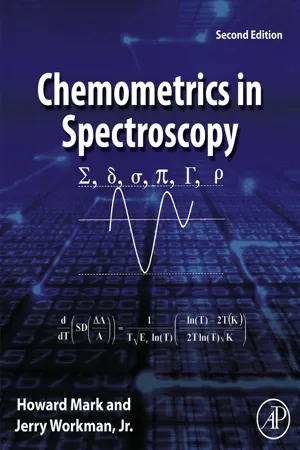
- 1,090 pages
- English
- ePUB (mobile friendly)
- Available on iOS & Android
Chemometrics in Spectroscopy
About this book
Chemometrics in Spectroscopy, Second Edition, provides the reader with the methodology crucial to apply chemometrics to real world data. It allows scientists using spectroscopic instruments to find explanations and solutions to their problems when they are confronted with unexpected and unexplained results. Unlike other books on these topics, it explains the root causes of the phenomena that lead to these results. While books on NIR spectroscopy sometimes cover basic chemometrics, they do not mention many of the advanced topics this book discusses. In addition, traditional chemometrics books do not cover spectroscopy to the point of understanding the basis for the underlying phenomena.The second edition has been expanded with 50% more content covering advances in the field that have occurred in the last 10 years, including calibration transfer, units of measure in spectroscopy, principal components, clinical data reporting, classical least squares, regression models, spectral transfer, and more.- Written in the column format of the authors' online magazine- Presents topical and important chapters for those involved in analysis work, both research and routine- Focuses on practical issues in the implementation of chemometrics for NIR Spectroscopy- Includes a companion website with 350 additional color figures that illustrate CLS concepts
Frequently asked questions
- Essential is ideal for learners and professionals who enjoy exploring a wide range of subjects. Access the Essential Library with 800,000+ trusted titles and best-sellers across business, personal growth, and the humanities. Includes unlimited reading time and Standard Read Aloud voice.
- Complete: Perfect for advanced learners and researchers needing full, unrestricted access. Unlock 1.4M+ books across hundreds of subjects, including academic and specialized titles. The Complete Plan also includes advanced features like Premium Read Aloud and Research Assistant.
Please note we cannot support devices running on iOS 13 and Android 7 or earlier. Learn more about using the app.
Information
Table of contents
- Cover image
- Title page
- Table of Contents
- Copyright
- Dedication
- Preface to the First Edition
- Preface to the Second Edition
- Chapter 1: A New Beginning …
- Section 1: Elementary Matrix Algebra
- Section 2: Matrix Algebra and Multiple Linear Regression
- Section 3: Experimental Designs
- Section 4: Analytic Geometry
- Section 5: Regression Techniques
- Section 6: Linearity in Calibration
- Section 7: Collaborative Laboratory Studies
- Section 8: Analysis of Noise
- Section 9: Derivatives
- Section 10: Goodness of Fit Statistics
- Section 11: More About Linearity in Calibration
- Section 12: Connecting Chemometrics to Statistics
- Section 13: Limitations in Analytical Accuracy
- Section 14: Derivations of Principal Components
- Section 15: Clinical Data Reporting
- Section 16: Classical Least Squares (CLS)
- Section 17: Transfer of Calibrations
- Section 18: The Importance of Units of Measure
- Section 19: The Best Calibration Model
- Section 20: Statistics
- Section 21: Outliers
- Section 22: Spectral Transfer: Making Instruments Agree
- Section 23: Applying Standard Reference Materials
- Section 24: More About CLS
- Index